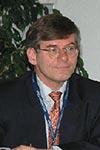
Stef Stienstra
Strategic Functional Specialist Health & Environment, The Netherlands
Title: Managing Bio-security Information
Biography
Biography: Stef Stienstra
Abstract
Introduction:
Sharing security threat information is a challenge for governments and their agencies. Especially in biotechnology and microbiology the agencies do not know how to classify information on potential bio-threats.
Methodology:
An example is the delay of the publication of the transmissibility of H5N1 avian influenza virus in Science by the Erasmus Medical Centre in Rotterdam, The Netherlands in 2012 as various organizations wanted to investigate whether the details could be misused. The study showed that only a small number of mutations would make it possible to change the H5N1 virus so it could spread through the air. Dangerous, but this information is also useful to develop new therapies and/or vaccines.
Discussion:
The knowledge of these natural mutation mechanisms could be misused to weaponize micro-organisms. It enables the engineering of the lethality, like it is done with some anthrax strains. Should these laboratory techniques be classified? Academics want to publish for the progress of science to find useful applications. The Rotterdam scientists were really annoyed when their research was blocked for publication and feared that other groups would be first in publishing a part of their obtained experimental results.
Conclusion:
Biosafety is already common practice in micro-biology, but biosecurity is often still questionable. A ‘Code of Conduct’, like the Dutch Academy of Science has developed, would help; especially for the so-called insider risk. Educational programs for the identification and assessment of risks and threats to security have to be developed to give scientists bio-threat awareness and for government officials to rationalize the real threat, without damaging the progress of science.
